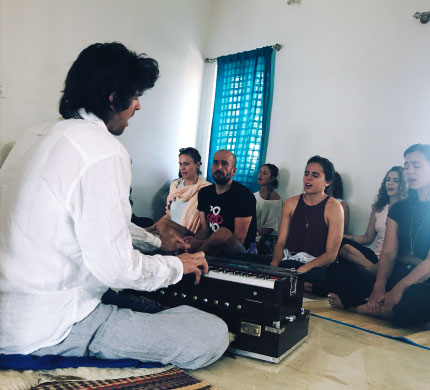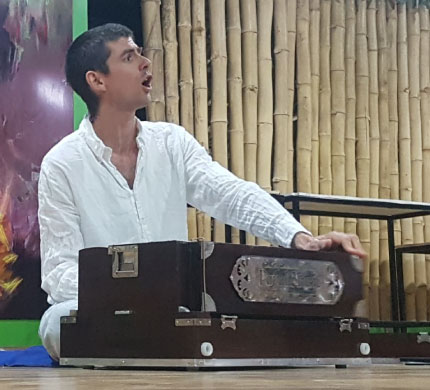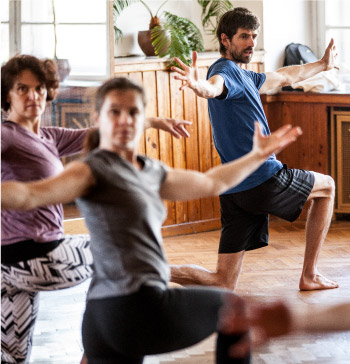
Discover the Power of Kīrtan and the Yoga of Sound and Song
The glorious practice of kīrtan is as old as human life. Wherever you came out of the womb, whoever your parents were, your heritage is of song and dance, of gathering around the fire, the hearth – in what some call the heart space – to share song, dance, story, food and fellowship and to create our own, collaborative, participative entertainment. Singing together (and dancing and listening and so on) nourishes a cell deep memory of the power of being an incarnate human and the magic of contributing to the family of life.
Kīrtan is a practice that helps us come together, individually and as a group. It helps energy and emotion move and circulate and allows us to express grief and praise, longing and belonging, reverence, enthusiasm and exultation. When we come together to sing with others, we can create and tune in to a unique symphony that provokes a recreational dance at the cellular level of our being. Bathing in sound that penetrates and pervades we can refresh ourselves in ways that other practice techniques are not always able to.
Eight Reasons to Love Kīrtan
CONNECT ON A DEEPER LEVEL
When we sing together, it helps us connect at a level before, beneath and beyond ideas.
SOUND THERAPY FOR THE BODY
Kīrtan reaches the parts that other practices aren’t always able to. Sound penetrates, pervades and invites all our cells to vibrate and come into greater harmonisation.
ACTIVE PARTICIPATION IN ENTERTAINMENT
Singing together reminds us, experientially, that the richest, deepest, most nourishing entertainment is in forms that we actively participate in.
CLEANSE AND PURIFY WITH SOUND
Kīrtan allows me to bathe in sound and wash away a lot of the detritus that can accumulate on the surface, in the nooks and crannies, and deeper in the field of my being.
YOGA OF SINGING
When I sing I invite myself into yoga whether I like it or not! Singing is pretty much straight away a yogic exercise, one that invites my sensory, physical, physiological, energetic, mental, intellectual, expressive and emotional powers to all participate at once, in mutually supportive togetherness.
SUPPORT FOR BREATHING PRACTICES
Kīrtan is a relatively straightforward way to invite and support prāṇāyāma: extension of the life force and refinement of the breath.
RESONANT REWARD
RECONNECTING WITH HUMAN HERITAGE
Kīrtan vivifies my connection to my living human heritage. Wherever we came out of the womb, we are descended from people who sang, and danced and shared stories and food around a fire.




Frequently Asked Questions About Kīrtan
What is that instrument you play?
Well, first and foremost, the voice! I often sing and share kīrtan a capella. This is how I started. Indeed, this is how it all started, with the human voice, telling and expressing the glory of life and existence. For many years I shared kīrtan only a capella and I often still do.
Sometimes I also play the instrument known as a harmonium. As far as I’m aware, the more compact type of harmonium which I play, was ‘invented’ in India. The story I was told was that during the colonial period, the British would sometimes ship over massive and extremely heavy parts to install organs in some of the churches they built in India. One day, a local says, ‘you know, you don’t really need all these ten-ton pipes. We could make a more compact version that would do a similar job’. And he then went on to fashion a wooden harmonium not unlike the ones that I sometimes play. From that time, the harmonium became a fairly common instrument in music of the lands that are now India, Pakistan and Bangladesh.
The harmonium is not however strictly speaking a classical Indian instrument. Some would say it is a ‘second class’ instrument, because it can only play fixed notes, it cannot slide between the notes and play the full range that a stringed instrument can. It cannot replicate or approach the same versatility as the voice.
That said, the harmonium can be a great support for the voice. As a base layer of accompaniment it can facilitate and support group singing. And the fixed notes are still very useful for exercising the voice!
While compact compared to a church organ or piano, the harmonium is still not so easy to transport, too big to carry on an aeroplane in standard class for example, quite heavy, and not so happy when subjected to jolts or lots of changes in temperature and humidity. Sometimes I do travel with a harmonium and I enjoy playing them in kīrtan. However, I also often lead kīrtan a capella, and did so entirely like this for several years before I ever used a harmonium.
I love both ways. I also enjoy sometimes playing with other instrumentalists. The harmonium can be great to play with percussionists, and it can help lend and evoke certain moods. A capella kīrtan meanwhile is often more meditative and I especially enjoy it on a certain type of afternoon. Another ‘glory’ of a capella kīrtan is its simplicity and richness. Just with our voice we can create something. Just by making simple sounds we can shift our vibration, and if singing with others, we can experience our voice as part of a symphonic whole.
But what if I can’t sing?
While we are all descended from peoples who sang as part of daily life, unfortunately, in recent times, in many parts of the world, we have become estranged from this heritage. Rather than be something simple, everpresent, woven into the day to day, singing and music has become more siloed, and is now tragically often regarded only as the preserve of specialist musicians and singers.
Many people were told terrible lies when they were children:
‘You have no voice for singing’, or some variant of it. Or they were shamed and told to ‘pipe down’ when they were using their voice in one of its intrinsically powerful ways to shake off emotion and cleanse our mental space.
Or, even more ridiculously, the young child, standing there with heart beating, in a bodily vehicle pulsating like everything else in existence, ‘you have no rhythm’. Again, ridiculous, but also tragic.
As one singer I have enjoyed working with says: ‘The whales are the great mammals of the ocean, and their song travels around the globe. We are the great mammals of the earth, but so many of us have stopped singing our song, and our Mother Earth is longing to hear our song.’
To some it may sound somewhat airy-fairy, ‘woo’, or whatever dismissive adjective they prefer, but the reality is that song and sounding helps us communicate and come together at levels deeper and subtler than spoken language. When we sing together we can share, communicate and co-create at a level before, beneath and beyond the beliefs, ideas and notions that often divide us. Communities that sing together know something about working together. Singing together can invite us into a space where we gain experiential understanding of what it means to work and come together beyond many of the differences that sometimes have come to separate us. We may realise for example, that by working with our unique gifts, singing our authentic song, we can actually contribute to a whole so much greater than we can reach if we keep our song to ourself.
This also applies at the individual level. When we give ourselves permission to sing, to express through sound, we actively advance our own yoga recovery project, reclaiming parts of ourselves we had allowed ourselves to become distant from, and attuning more to our own unique voice.
The joy, power and transformative benefits of kīrtan are open to everyone.
When we give ourselves to the song, it gives back to us. When we allow ourselves to explore singing simply, we may surprise ourselves by experiencing the resonant richness of our voice being part of a moving, collective sound. When we give ourselves to listening, we may also discover that we can attune to the sound, let it wash through us and find ourselves refreshed and uplifted.
What songs do you sing at kīrtan?
The first thing we usually do is make some simple vowel sounds together. The effects of this can be quite extraordinary. We may quite quickly notice a shift in our vibration and experience our voice quite magically mingling with others and becoming part of a rich whole.
What songs we sing will depend to some degree on where we are, the group, how much time we have and how familiar people are with Sanskṛt. I share songs in several languages, but often too a kīrtan may use all or mainly songs in Sanskṛt. Many of these are simple and very accessible. Sanskṛt literally means ‘well done’, ‘well made’, ‘well put together’. The sounds of Sanskṛt span the vocal apparatus and are crisp and clean. Once one has been introduced to the sounds, they are relatively easy to replicate. In Sanskṛt, there is significant correspondence between name and form – between nāma and rūpa. The Sanskṛt words and names we sing in kīrtan are pregnant with rich layers of archetypal meaning. As we sing them, we evoke and call forth particular types of energy that help us attune to greater harmony. The names that we sing are also associated with rich symbolism and many stories. As we attune to them, we invite their helpful, harmonising qualities to resound more vibrantly through our being.

Programs
SIGN UP >

Work With James
LEARN MORE >

Store
COMING SOON
Whole Life Yoga Newsletter
The place to find out first about all James’ programs and offerings, receive articles, recommendations, and access special rates for programs.
